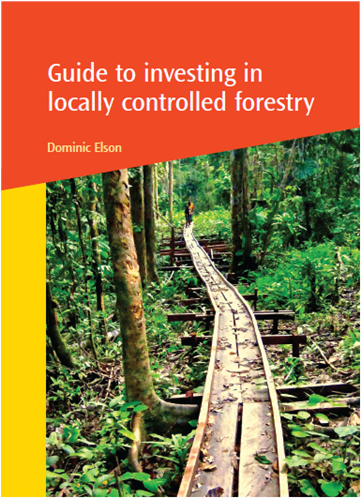Guide to investing in locally controlled forestry
This guide to Investing in Locally Controlled Forestry (ILCF) is an outcome of the Growing Forest Partnerships initiative that engaged The Forests Dialogue to co-ordinate 11 wideranging dialogues involving investors, rights-holders, governments, donors and others on this topic. It is primarily a tool for practical action and its advice draws on strong evidence showing that locally-controlled forestry enterprises can be successful, sustainable and profitable for all stakeholders. It offers a market-based view of development, rooted in an understanding of the globalised, free-market economy, and concentrates on a role for Small Medium Entreprises (SMEs) – the ‘missing middle’ of many developing economies.

Photo: LCF/IUCN
ILCF offers investors secure access, a ‘social licence to operate’, reduced risks and better long term management opportunities, as well as evidence of social and environmental sustainability. Rights-holders gain from reinforced tenure rights that in turn underpin resilient local economies. Governments stand to gain better asset protection, and bottom-up rural economic development that, in time, contributes to tax revenues. Internationally, locally controlled forestry holds the key to a better approach to reducing carbon emissions in the land use sector and thereby offers a way forward for REDD+.
Strong businesses generate profits worthy of asset investment. But growing those businesses may need enabling investments from NGOs, philanthropists or governments for infrastructure or capacity building. Recognising these two investment roles offers a credible way to bridge the ‘SME funding’ gap, where enterprises that are too big for microfinance often struggle with the step change needed to attract conventional investment or financial services. Distinguishing between enabling and asset investments is essential in packaging investments that are acceptable to all parties.
ILCF provides structured tactical advice for building the alliances and partnerships needed for successful ILCF, both among rights-holders and between rights-holders, their investors, intermediaries and governments. These partnerships in turn rely on essential ‘favourable conditions’, both internally and externally, and the guide sets these out in detail. For example, enterprises need strong enough internal organisational and management strategies to attract investors, and here capacity building from specialist Business Development Service Providers can help. Externally, sufficient clarity of tenure is essential
for investment, and this can only come about by bringing together rights-holders, government and investors. Clarity of tenure requires ‘good enough governance’, and that needs investors, donors and companies to actively support, and not undermine, governance institutions.
Yet however essential, alliances are not without risks and drawbacks for enterprises, and the guide covers the issues of ‘co-dependency’ with NGO and donor intermediaries, and the balance of initial help and long term limitations hidden within company-community partnerships – often set up when local enterprises are not yet strong enough to attract their own investment.
Finally, seventeen case studies from across the world, from start-ups to long established businesses, in both developed and developing countries offer a flavour of the huge opportunities for investing in locally controlled forestry. The Forests Dialogue hopes this guide will inspire and support many more.



